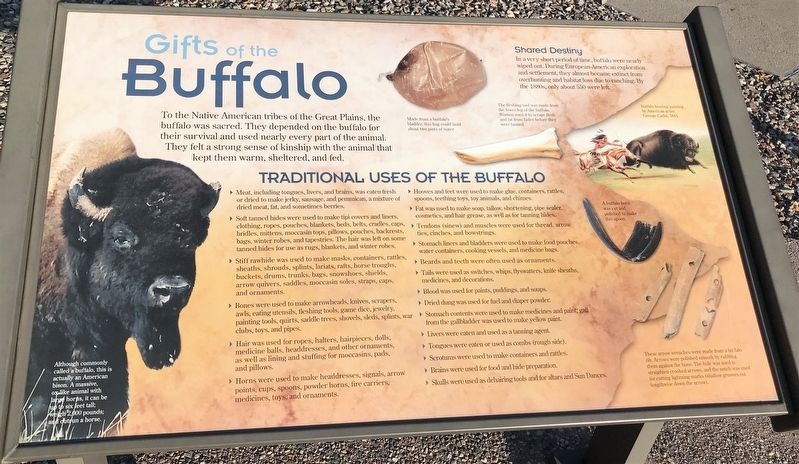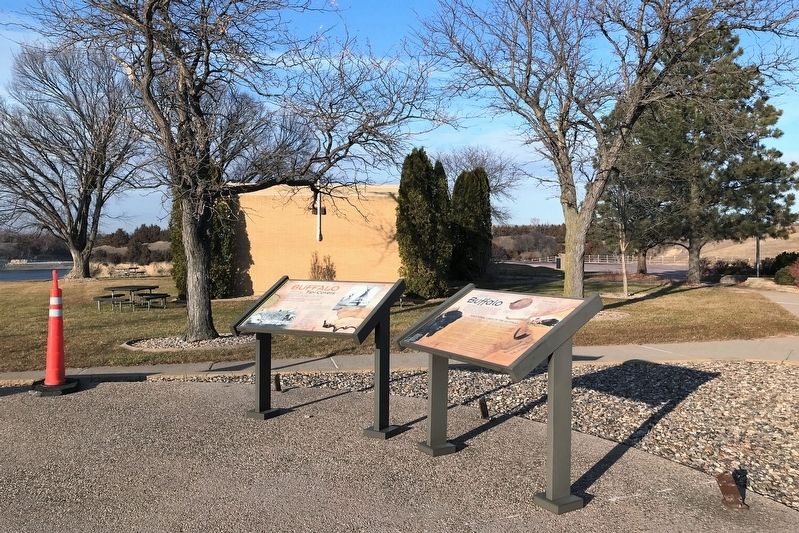Near Pickstown in Charles Mix County, South Dakota — The American Midwest (Upper Plains)
Gifts of the Buffalo
To the Native American tribes of the Great Plains, the buffalo was sacred. They depended on the buffalo for their survival and used nearly every part of the animal. They felt a strong sense of kinship with the animal that kept them warm, sheltered, and fed.
Traditional Uses of the Buffalo
▸Meat, including tongues, livers, and brains, was eaten fresh, or dried to make jerky, sausage, and pemmican, a mixture of dried meat, fat, and sometimes berries.
▸Soft tanned hides were used to make tipi covers and liners, clothing, ropes, pouches, blankets, beds, belts, cradles, caps, bridles, mittens, moccasin tops, pillows, pouches, backrests, bags, winter robes, and tapestries. The hair was left on some tanned hides for use as rugs, blankets, and winter robes.
▸Stiff rawhide was used to make masks, containers, rattles, sheaths, shrouds, splints, lariats, rafts, horse troughs, buckets, drums, trunks, bags, snowshoes, shields, arrow quivers, saddles, moccasin soles, straps, caps, and ornaments.
▸Bones were used to make arrowheads, knives, scrapers, awls, eating utensils, fleshing tools, game dice, jewelry, painting tools, quirts, saddle trees, shovels, sleds, splints, war clubs, toys, and pipes.
▸Hair was used for ropes, halters, hairpieces, dolls, medicine balls, headdresses, and other ornaments, as well as lining and stuffing for moccasins, pads, and pillows.
▸Horns were used to make headdresses, signals, arrow points, cups, spoons, powder horns, fire carriers, medicines, toys, and ornaments.
▸Hooves and feet were used to make glue, containers, rattles, spoons, teething toys, toy animals, and chimes.
▸Fat was used to make soap, tallow, shortening, pipe sealer, cosmetics, and hair grease, as well as for tanning hides.
▸Tendons (sinew) and muscles were used for thread, arrow ties, cinches, and bowstrings.
▸Stomach liners and bladders were used to make food pouches, water containers, cooking vessels, and medicine bags.
▸Beards and teeth were often used as ornaments.
▸Tails were used as switches, whips, flyswatters, knife sheaths, medicines, and decorations.
▸Blood was used for paints, puddings, and soups.
▸Dried dung was used for fuel and diaper powder.
▸Stomach contents were used to make medicines and paint; gall from the gallbladder was used to make yellow paint.
▸Livers were eaten and used as a tanning agent.
▸Tongues were eaten or used as combs (rough side).
▸Scrotums were used to make containers and rattles.
▸Brains were used for food and hide preparation.
▸Skulls were used as dehairing tools and for altars and Sun Dances.
Shared Destiny
In a very short period of time, buffalo were nearly wiped out. During European-American exploration and settlement, they almost became extinct from overhunting and habitat loss due to ranching. By the 1880s, only about 550 were left.
[Captions:]
Made from a buffalo's bladder, this bag could hold about two pints of water.
The fleshing tool was made from the lower leg of the buffalo. Women used it to scrape flesh and fat from hides before they were tanned.
Buffalo hunting painting by American artist George Catlin, 1844.
A buffalo horn was cut and polished to make this spoon.
These arrow wrenches were made from a buffalo rib. Arrows were polished smooth by rubbing them against the bone. The hole was used to straighten crooked arrows, and the notch was used for cutting lightning marks (shallow grooves cut lengthwise down the arrow).
Although commonly called a buffalo, this is actually an American bison. A massive, ox-like animal with large horns, it can be up to six feet tall; weigh 2,000 pounds; and outrun a horse.
Topics. This historical marker is listed in these topic lists: Animals • Anthropology & Archaeology • Native Americans.
Location. 43° 4.163′ N, 98° 32.735′ W. Marker is near Pickstown, South Dakota, in Charles Mix County. Marker is on U.S. 18, half a mile west of Missouri Drive, on the right when traveling west. The marker stands at the Fort Randall Dam Visitor Center. Touch for map. Marker is in this post office area: Lake Andes SD 57356, United States of America. Touch for directions.
Other nearby markers. At least 8 other markers are within walking distance of this marker. Buffalo Tipi Covers (here, next to this marker); Tipi: "They Dwell" (here, next to this marker); Women's Work: Making & Raising Tipis (here, next to this marker); Circle of Life (here, next to this marker); Star Power (here, next to this marker); Fort Randall Dam - Lake Francis Case (a few steps from this marker); Pickstown / Lewis and Clark (approx. 0.7 miles away); Pickstown Centennial Garden Memorial (approx. 0.7 miles away). Touch for a list and map of all markers in Pickstown.
Credits. This page was last revised on December 6, 2021. It was originally submitted on December 6, 2021. This page has been viewed 159 times since then and 39 times this year. Photos: 1, 2. submitted on December 6, 2021. • Devry Becker Jones was the editor who published this page.

